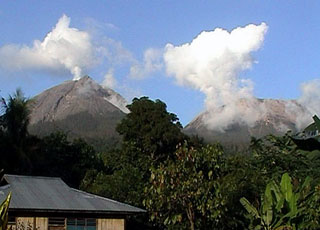Report on Lewotobi (Indonesia) — 31 August-6 September 2011
Smithsonian Institution / US Geological Survey
Weekly Volcanic Activity Report, 31 August-6 September 2011
Managing Editor: Sally Sennert.
Please cite this report as:
Global Volcanism Program, 2011. Report on Lewotobi (Indonesia) (Sennert, S, ed.). Weekly Volcanic Activity Report, 31 August-6 September 2011. Smithsonian Institution and US Geological Survey.
Lewotobi
Indonesia
8.542°S, 122.775°E; summit elev. 1703 m
All times are local (unless otherwise noted)
CVGHM reported that during 26-31 August seismicity at Lewotobi increased. Plumes of "smoke" rose 15-50 m above the Lewotobi Perampuan crater rim; no other significant changes were visibly apparent. Based on the seismic data, the Alert Level was raised to 2 (on a scale of 1-4) on 31 August. Visitors and residents were advised not to approach the volcano within 1 km of the Lewotobi Perampuan crater.
Geological Summary. The Lewotobi edifice in eastern Flores Island is composed of the two adjacent Lewotobi Laki-laki and Lewotobi Perempuan stratovolcanoes (the "husband and wife"). Their summits are less than 2 km apart along a NW-SE line. The conical Laki-laki to the NW has been frequently active during the 19th and 20th centuries, while the taller and broader Perempuan has had observed eruptions in 1921 and 1935. Small lava domes have grown during the 20th century in both of the summit craters, which are open to the north. A prominent cone, Iliwokar, occurs on the E flank of Perampuan.
Source: Pusat Vulkanologi dan Mitigasi Bencana Geologi (PVMBG, also known as CVGHM)

